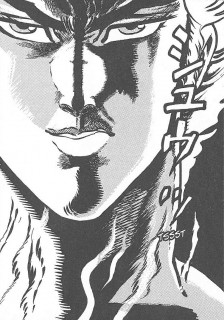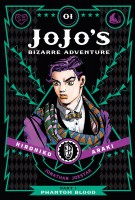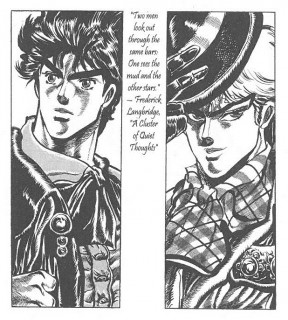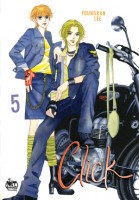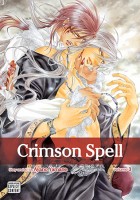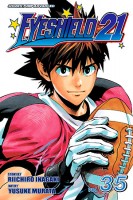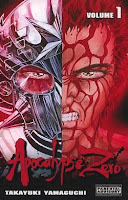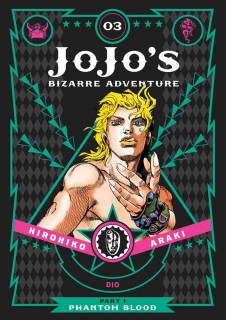 Creator: Hirohiko Araki
Creator: Hirohiko Araki
U.S. publisher: Viz Media
ISBN: 9781421578804
Released: August 2015
Original release: 1988
Although I had been previously aware of the manga series for some time, my real introduction to Hirohiko Araki’s multi-generational shounen epic JoJo’s Bizarre Adventure was in 2012 through the standalone spinoff Rohan at the Louvre. I then proceeded to read the third story arc Stardust Crusaders, at the time the only other part of JoJo’s Bizarre Adventure to have been released English. It wasn’t until 2015 that Phantom Blood, the very beginning of JoJo’s Bizarre Adventure was translated, published in a beautiful hardcover edition under Viz Media’s Shonen Jump imprint. When Phantom Blood was originally collected in Japan it was released in five volumes between 1987 and 1988. However, in 2002 it was re-released in three volumes which is what Viz Media’s edition is based on. Phantom Blood, Volume 3, published in English in 2015, is largely equivalent to the fourth and fifth volumes of the original Japanese release.
Having arrived in Wind Knights Lot in pursuit of his adoptive brother Dio, Jonathan Joestar must first successfully defeat two of Dio’s strongest undead minions and then traverse a town with a population that is steadily being turned into a hoard of zombies before he even has the chance to confront his brother. The Dark Knight Blueford, who is filled with hatred for the world and loyalty to Dio, is determined to take JoJo’s life. The other knight, Tarukus, is also exceptionally skilled when it comes to dealing out death and takes great delight in it. Should JoJo and his allies manage to survive their encounter with these two undead foe, they face an even more formidable adversary in Dio. Having used an ancient stone mask to turn himself into a vampire, Dio has gained untold strength and powers. Fortunately, JoJo is a quick and talented study—under the tutelage of Baron Zeppeli he has been able to begin to master Hamon energy, the only thing other than the sun itself that can harm to Dio.
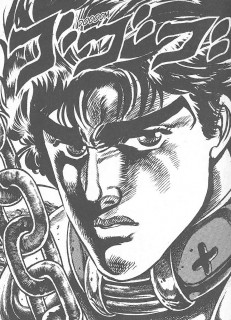 JoJo’s Bizarre Adventure truly is a bizarre series; Phantom Blood makes this very clear from the very start. From the characters’ weird anatomy and disproportionate musculature to the story’s strange mix of melodrama, horror, and fantastic martial arts, Phantom Blood doesn’t just strain readers’ suspension of disbelief, the manga completely shatters it. Entire backstories are revealed in the time it takes for characters to tumble down cliff sides; combatants continue to live on after suffering injures that even the undead couldn’t survive; fights quickly escalate to unbelievable extremes, opponents continuously outdoing and outmaneuvering one another. Although the “why” of what’s going on is sometimes questionable, even considering Araki’s pseudo-scientific explanations, most everything is blatantly narrated by the participants and observers, so it’s fairly easy to at least follow the “what” of all of the strangeness. JoJo’s Bizarre Adventure is admittedly ridiculous and absurd, but that’s part of what makes the series so entertaining.
JoJo’s Bizarre Adventure truly is a bizarre series; Phantom Blood makes this very clear from the very start. From the characters’ weird anatomy and disproportionate musculature to the story’s strange mix of melodrama, horror, and fantastic martial arts, Phantom Blood doesn’t just strain readers’ suspension of disbelief, the manga completely shatters it. Entire backstories are revealed in the time it takes for characters to tumble down cliff sides; combatants continue to live on after suffering injures that even the undead couldn’t survive; fights quickly escalate to unbelievable extremes, opponents continuously outdoing and outmaneuvering one another. Although the “why” of what’s going on is sometimes questionable, even considering Araki’s pseudo-scientific explanations, most everything is blatantly narrated by the participants and observers, so it’s fairly easy to at least follow the “what” of all of the strangeness. JoJo’s Bizarre Adventure is admittedly ridiculous and absurd, but that’s part of what makes the series so entertaining.
Phantom Blood is a relatively short series, especially when compared to the later story arcs of JoJo’s Bizarre Adventure. While Phantom Blood is a complete story in its own right, if often feels even more like a prologue to the rest of the series, laying the groundwork for all of the weirdness and machismo to come. Phantom Blood introduces the noble Joestar family—Jonathan in particular being especially gallant and large-hearted, even towards his enemies—but even more important is the introduction of Dio, an extraordinary villain. As Araki points out in the volume’s author notes, what make Dio so terrifying isn’t his impressive powers or brute strength, it’s his stunning ability to control others. Dio is arrogant but extremely charismatic, gaining many willing followers and easily manipulating those who aren’t. Phantom Blood is frequently gruesome and grotesque, with over-the-top violence, outrageous story developments, and audacious, larger-than-life characters. JoJo’s Bizarre Adventure is a peculiar work, but I’m definitely looking forward to reading the next arc, Battle Tendency.


